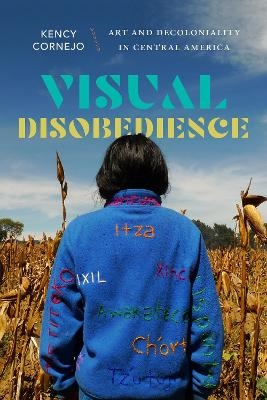
Visual Disobedience
Art and Decoloniality in Central America
Seiten
2024
Duke University Press (Verlag)
978-1-4780-3054-6 (ISBN)
Duke University Press (Verlag)
978-1-4780-3054-6 (ISBN)
Kency Cornejo traces the emergence of new artistic strategies for Indigenous feminist resistance in the wake of torture, disappearance, killings, and US-funded civil wars in Central America.
In Visual Disobedience, Kency Cornejo traces the emergence of new artistic strategies for Indigenous, feminist, and anticarceral resistance in the wake of torture, disappearance, killings, and US-funded civil wars in Central America. Cornejo reveals a direct line from US intervention to current forms of racial, economic, and gender injustice in the isthmus, connecting this to the criminalization and incarceration of migrants at the US-Mexico border today. Drawing on interviews with Central American artists and curators, she theorizes a form of “visual disobedience” in which art operates in opposition to nation-states, colonialism, and visual coloniality. She counters historical erasure by examining over eighty artworks and highlighting forty artists across the region. Cornejo also rejects the normalized image of the suffering Central American individual by repositioning artists as creative agents of their own realities. With this comprehensive exploration of contemporary Central American art, Cornejo highlights the role of visual disobedience as a strategy of decolonial aesthetics to expose and combat coloniality, heteropatriarchy, white supremacy, empire, and other systems of oppression.
In Visual Disobedience, Kency Cornejo traces the emergence of new artistic strategies for Indigenous, feminist, and anticarceral resistance in the wake of torture, disappearance, killings, and US-funded civil wars in Central America. Cornejo reveals a direct line from US intervention to current forms of racial, economic, and gender injustice in the isthmus, connecting this to the criminalization and incarceration of migrants at the US-Mexico border today. Drawing on interviews with Central American artists and curators, she theorizes a form of “visual disobedience” in which art operates in opposition to nation-states, colonialism, and visual coloniality. She counters historical erasure by examining over eighty artworks and highlighting forty artists across the region. Cornejo also rejects the normalized image of the suffering Central American individual by repositioning artists as creative agents of their own realities. With this comprehensive exploration of contemporary Central American art, Cornejo highlights the role of visual disobedience as a strategy of decolonial aesthetics to expose and combat coloniality, heteropatriarchy, white supremacy, empire, and other systems of oppression.
Kency Cornejo is Associate Professor of Art History at the University of New Mexico.
List of Illustrations ix
Acknowledgments xix
Introduction. Against Visual Coloniality 1
1. Semillas: Art and Indigenous Defiance in Guatemala 35
2. A Creative Turn to the Body: Feminist Dissonance and Erotic Autonomy in Central American Art 78
3. Shifting the Border: Central American Art against the War on Mobility 132
4. “Los Siempre Sospechosos de Todo”: Art on Criminalization, Prisons, and Social Cleansing in Central America 177
Conclusion. Visual Disobedience and Art Histories Otherwise 231
Notes 239
Bibliography 257
Index 271
| Erscheinungsdatum | 19.10.2024 |
|---|---|
| Reihe/Serie | Dissident Acts |
| Zusatzinfo | 91 color illustrations |
| Verlagsort | North Carolina |
| Sprache | englisch |
| Maße | 152 x 229 mm |
| Gewicht | 680 g |
| Themenwelt | Kunst / Musik / Theater ► Kunstgeschichte / Kunststile |
| Geisteswissenschaften ► Geschichte ► Regional- / Ländergeschichte | |
| Geschichte ► Teilgebiete der Geschichte ► Wirtschaftsgeschichte | |
| Sozialwissenschaften ► Politik / Verwaltung | |
| ISBN-10 | 1-4780-3054-2 / 1478030542 |
| ISBN-13 | 978-1-4780-3054-6 / 9781478030546 |
| Zustand | Neuware |
| Informationen gemäß Produktsicherheitsverordnung (GPSR) | |
| Haben Sie eine Frage zum Produkt? |
Mehr entdecken
aus dem Bereich
aus dem Bereich
die Ukraine, Polen und der Irrweg in der russischen Geschichte
Buch | Hardcover (2023)
C.H.Beck (Verlag)
CHF 39,20
eine Globalgeschichte des Kapitalismus
Buch | Hardcover (2023)
C.H.Beck (Verlag)
CHF 53,20


